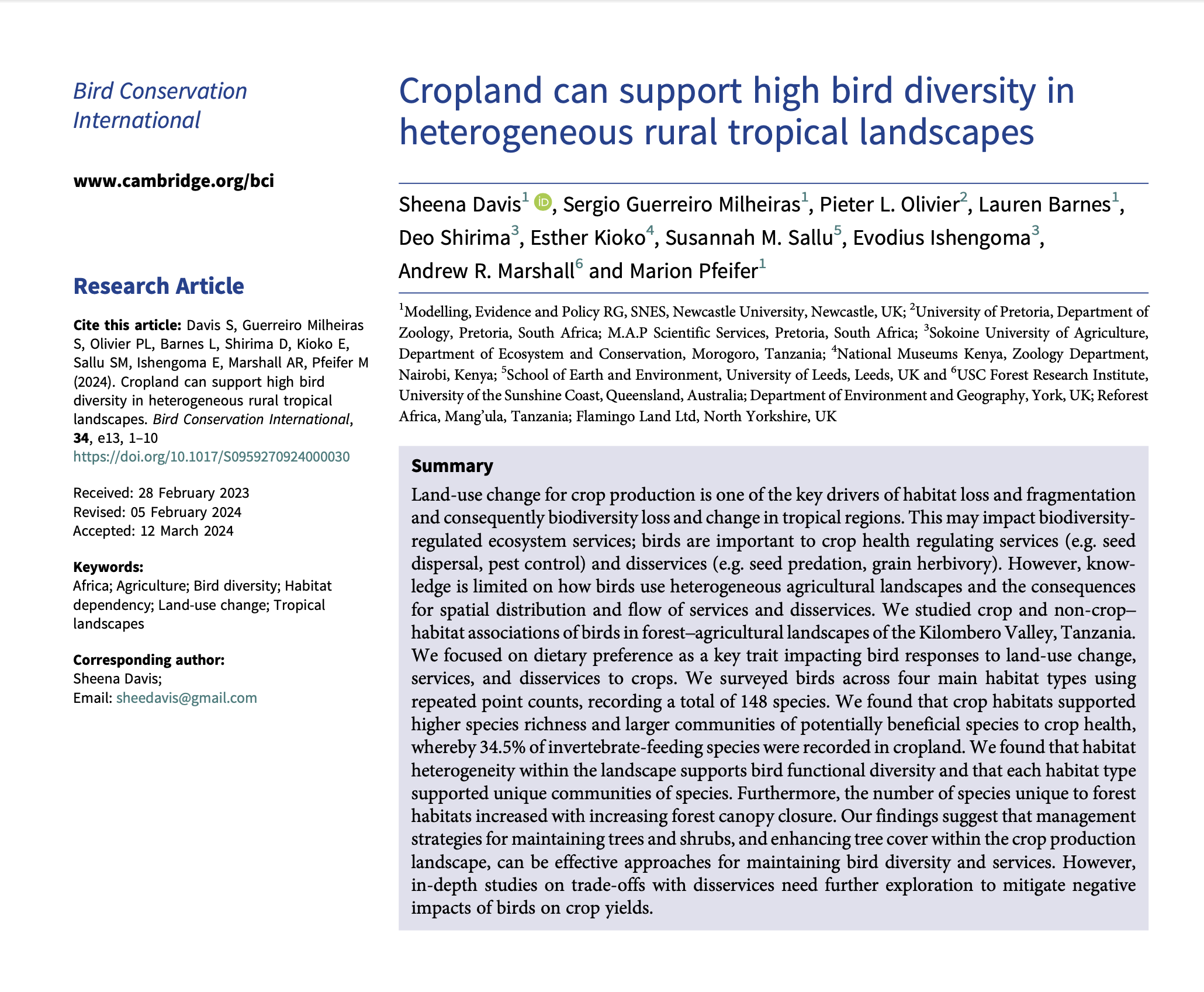Juma M Msafiri
Nestled in southern-central Tanzania, the Kilombero Valley offers a unique perspective on the intersection of agriculture and biodiversity. This fertile valley, defined by the Udzungwa and Nyerere National Parks on its flanks, is a critical part of the Southern Agricultural Growth Corridor of Tanzania (SAGOT). Recent research conducted here reveals intriguing dynamics between land use and bird diversity, suggesting that agricultural practices can harmoniously coexist with and even enhance biodiversity.
Study Background and Area: The Kilombero Valley is characterized by its vast freshwater floodplain, supporting high biodiversity levels, including several endemic bird species like the Kilombero Cisticola and White-tailed Cisticola. The landscape’s distinct wet season and fertile soils have made it an agricultural hub. However, this has also led to significant environmental changes, including habitat fragmentation and biodiversity shifts, primarily due to extensive farming.
A study led by Sheena Davis from Newcastle University, alongside a team of international researchers, has meticulously explored how different forms of land use within the valley influence bird populations. The study spans various habitats, from untouched forests to smallholder farms and large-scale plantations, using a blend of empirical data collection and advanced analytical techniques.
Methodological Excellence: The research employed point count surveys at 124 locations across the valley to record bird species and assess their habitat associations. Advanced statistical models, including random forest models for land cover classification and dietary preference analysis from the Elton Traits database, were pivotal in understanding the complex interactions between birds and their environment.
This comprehensive approach allowed the team to delve into how birds adapt to an environment marked by both natural and anthropogenic influences. By categorizing habitats and analyzing bird counts in conjunction with environmental factors like forest canopy closure and proximity to human settlements, the study provided a nuanced understanding of biodiversity in agricultural settings.
Findings: A Case for Biodiversity in Croplands: Contrary to traditional views that agriculture is detrimental to biodiversity, the findings from the Kilombero Valley paint a different picture. Surprisingly, croplands exhibited higher bird species richness compared to more natural forest settings. This richness was especially pronounced in smallholder farms, which often incorporate elements of natural vegetation and demonstrate less intensive farming practices than large-scale agricultural operations.
The diversity in smallholder farms likely stems from the heterogeneity of the landscape, where patches of natural vegetation are interspersed within cultivated lands. These elements serve as mini-refuges for wildlife, offering food, shelter, and nesting sites for a variety of bird species. The study highlights the critical role of maintaining this heterogeneity in promoting biodiversity within agricultural landscapes.
Ecological Insights and Conservation Implications: The study’s insights are particularly compelling in the context of ecological services that birds provide, such as pest control and seed dispersal. Bird species thriving in these agricultural areas can contribute significantly to natural pest management, reducing the need for chemical interventions that can have deleterious environmental impacts.
Moreover, the research underscores the importance of strategic land management practices that can bolster biodiversity. For instance, promoting agroforestry and integrating tree cover within croplands not only supports diverse bird populations but also enhances the overall ecological health of the area. This integrated approach can be a blueprint for balancing agricultural productivity with conservation goals in similar tropical landscapes worldwide.
Future Directions and Global Relevance: Building on these findings, there is a clear pathway for future research and policy-making. Studies that further explore the specific ecological roles of bird species in agricultural landscapes could provide deeper insights into optimizing land use practices that support both food production and biodiversity conservation.
Globally, the lessons from the Kilombero Valley apply to many parts of the world where agriculture and conservation are often seen in conflict. The evidence that agricultural landscapes, when managed with biodiversity in mind, can support rich ecosystems offers a hopeful perspective for sustainable development strategies that align ecological and human needs.
The Kilombero Valley study is a landmark in understanding how tropical agricultural landscapes can be managed to support biodiversity. By integrating ecological sensibilities with agricultural practices, it is possible to create landscapes that are productive and biologically rich. This research not only challenges prevailing notions about agriculture’s impact on biodiversity but also opens new avenues for sustainable farming practices that honor and preserve the natural world.
The research from the Kilombero Valley provides a crucial foundation for future conservation efforts and sustainable agricultural practices. It offers a compelling example of how thoughtful land management can yield significant benefits for biodiversity while sustaining agricultural productivity, providing a model for similar environments striving to balance these often competing priorities.
Full research document
